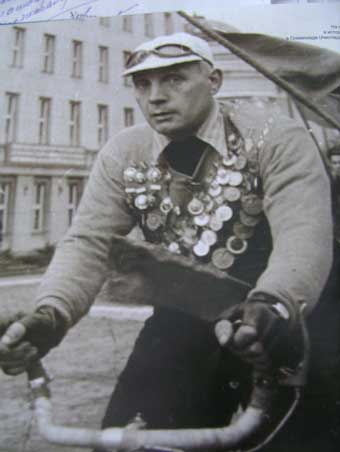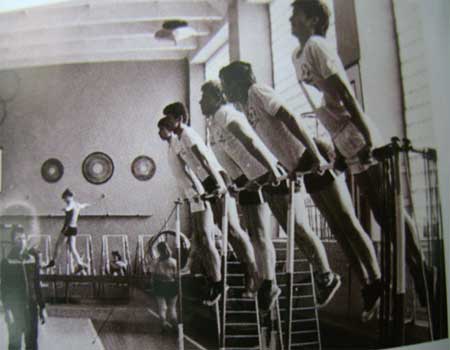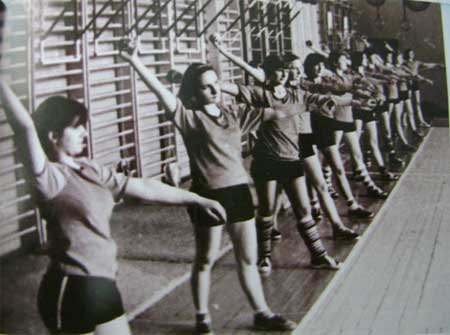Настройки шрифта
Arial
Times New Roman
Межбуквенное расстояние
Стандартное
Увеличенное
Большое
Цветовая схема
Черным
по белому
по белому
Белым
по черному
по черному
History of Physical Culture in Brest Region
14/03/2013 10:03

.jpg)


Documents, preserved in archives, testify that first physical culture communities arose in the city on Bug circa 120 years ago. These were small groups, created at educational establishments. Group members did such sports as swimming, rowing, cycling and skating in winter.
In 1893 was opened a branch of “Russian community of tourists-cyclists”. A group of enthusiasts made an unbelievable, for those times, run for 136 versts, going through the rout Brest-Kobrin-Verkholese-Velikorita-Brest. The event received a resonance; meanwhile Brest cyclists had another run for 132 versts.
For the first time Sport really drives attention only in the 20s when Brest became a center of Polesye voevodstva in Poland. In this period here as well as in Pinsk and in the other cities and settlements appeared various sport teams, sections and even large sports associations and unions. One of them, for instance, was sports-educational organization “Sokol”, main motto of the organization was “In healthy body – healthy mind”. In the center of the voevodship were operating two stadiums, where were held different football and volleyball tournaments and competitions (in football tournaments were partaking more than 10 teams, and the games attracted thousands of supporters), rowing was actively developing. Precisely in Polish period, in 30s, on the Bug river bank were constructed three rowing bases, which were perfectly equipped. One of them then was destroyed by fascists’ bomb, but the remaining two have successfully survived war times and served as basis for development of rowing in soviet times.
The greatest legend and the most noticeable man among sportsmen of those times was cyclist Nikolai Dranko. In 1928 Nikolai Dranko faces unbelievable fortune – he moves to Olympic games in Amsterdam in the composition of polish team. Dranko was the only one who brought scores for the team, he took 5th place on track. Press and specialists praised him. But Nikolai himself was disappointed: it had been possible to “roll” much better but I didn’t.
In 1939 Western Belarus as a r esult of well known political and war events was attached to USSR. Main attention was drawned to military construction and sovietization of new territories. Never the less in 40s in Brest was established regional committee for physical culture and sports (first chairman – Grigori Fialkin).
It was a successful start and work “on places” was started, popularization was a key factor in the work. For example, Sports school for children started its work in Pinsk. But soon came 22nd of June 1941, which crossed all peaceful planes and intentions.
Taking into consideration all hardships, on the 22 March 1945 was made a resolution of Brest executive committee of party and executive committee No 315, which stated organization bureau of committee for physical culture and sports affairs.
In December 1945 appeared managing resolution «About establishing of sports schools for youth», and on 22 January 1946 was accepted staff list of Brest school “for training of qualified sportsmen (without job interruption)» in quantity of 4.
In after war period work of Brest regional sports committee was restarted, which was headed by Nikolai Gordienko. In 1946 in Brest functioned volleyball, basketball, gymnastics, boxing, cycling, rowing and athletics sections. 920 people were doing athletics, but only 25 were doing rowing.
By 1947 the list of kinds of sports, cultivated in the region was broadened. 21 December 1947 finished first after war republican competitions of weightlifters. In the competitions took part weightlifters, wrestlers and boxers.
Delegation of Brest region took 3rd place, surprising specialists from the capital. Stadium “Locomotiv” and first stage of stadium “Spertak” were restored. Water station had been built on the river bank (“Mukhavets” river).
Development of sports structures was going step by step and was gaining speed. As a basis for going info sports were Voluntary sports communities (VSC). The biggest SVC at the end of 50’s beginning of 60’s was considered VSC “Urozhai”, but according to opinion of many trainers the most professional were the following VSC: “Spartak”, “Krasnoe znamia” and “Dinamo”.
Great results in rowing were achieved by Brest sportsmen in 50-60’s. Coach V.K. Pilipenko had prepared great sportsmen: S. Makarenko (champion of Olympiad games-1960, canoe), V. Naumov (champion of USSR) and more great masters. Nowadays these traditions are prolonged by V.V. Sinelschikov.
During many years schools were the main and the most important chain in the sphere of sports structure. Specialized athletics sport school was opened in 1955. In 1970 were established Junior sports schools (cycling and rowing). Later was given a start to establishing of Junior sports school of Olympic reserve. A great impulse for sports development was given by establishing of regional school of higher sports mastership in 1975.